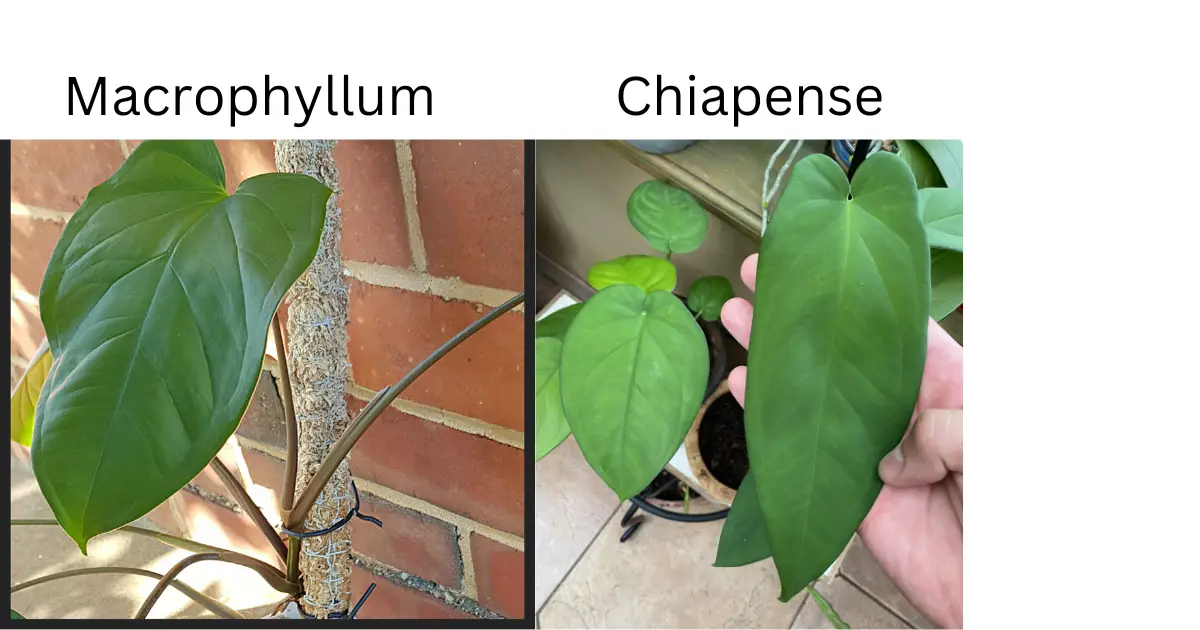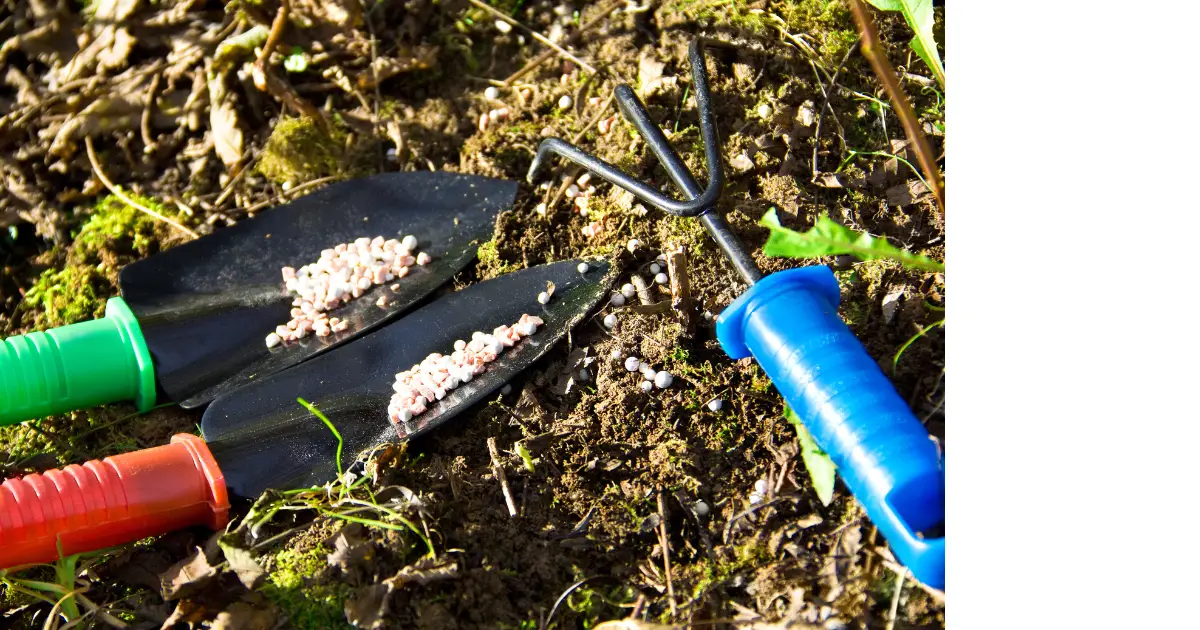In the juvenile stage, both macrophyllum vs chiapense look almost similar. As a result, many people can not tell them apart. But as they grow, their dissimilarities start to show.
So, what’s the difference between Syngonium macrophyllum vs chiapense?
Syngonium macrophyllum has lighter, glossy, long, and heart-shaped leaves while the chiapense has a matte, smaller and pointy-shaped leaves. The macrophyllum can grow around 10 feet long while the chiapense will grow at most 2.5 feet long. The macrophyllum has a light pink flower and needs fertilizing 2-3 times a week. Whereas, chiapense blooms white flowers and requires fertilizing once a month.
To know the differences in detail and to discover more about both plants, keep reading.
Syngonium Macrophyllum Vs Chiapense: Quick Comparison
Syngonium macrophyllum and chiapense mostly differ in their appearances. Here is a quick difference between these two plants.
| Features | Syngonium macrophyllum | Syngonium chiapense |
| Leaf Color & Texture | Darker and glossy | Lighter and matte |
| Leaf length | Up to 8 inches | Up to 4 inches |
| Leaf Shape | Round and heart-shaped | Pointy and leaner |
| Stem Appearance | Purple undertone | Greenish undertone |
| Length | Up to 6 to 10 feet long | Up to 2 to 2.50 feet long |
| Flower | Light pink | White |
| Fertilizer needs | 2-3 times a week | Once in a month |
| USDA Hardiness Zone | Zone 11 | Zone 9-10 |
Syngonium Macrophyllum Vs Chiapense: In-Depth Comparison
There is a common question for many people. Is Syngonium Chiapense the same as Macrophyllum? No, they are not the same. The major differences between them are described below in detail.
Leaf Color & Texture:
Mature macrophyllum is darker in color whereas Chiapensis lighter in color. Macrophyllum has a shiny or glossy texture, on the other hand, the Chiapense has a rubbery and matte texture.

Leaf Length:
Fully mature Macrophyllum leaves can grow as long as 8 inches, whereas Chiapense leaves grow at most 4 inches.
So, the Macrophyllum leaves will appear bushier than the Chiapense leaves.
Leaf Shape:
Syngonium Macrophyllum has more round and heart-shaped leaves, on the contrary, Chiapense has pointier and leaner leaves. Due to the heart shape of macrophyllum, it is very popular among gardeners and it is also called the Ice Frost or Frosted Heart plant.
If you are a fan of plants with heart-shaped leaves, you can also buy Anthurium, String of Hearts, Hoya Kerii, Philodendron gloriosum, and Morning Glory.
And for the pointy shape of the chiapense plant, it is also called the arrowhead plant.

Stem Appearance:
Syngonium macrophyllum stems have a purple or violet undertone while the chiapense stems have a greenish undertone.
On the surface of the stem, both plants are bluish-gray. Some Australian macrophyllum have completely purple stems which makes the plant more unique.
Length:
Syngonium macrophyllum is a way larger plant than chiapense.
Macrophyllum grows around 40 CM indoors and from 6 to 10 feet long outdoors. On the other hand, chiapense grows only up to 70 cm in nature.
Flower:
Syngonium macrophyllum blooms light pink colored flowers while the chiapense has a white spathe flower with a single tepal. Although, both plants bloom rarely. And indoors, they almost never bloom.
Fertilizer Needs:
Chiapense plants need to be fertilized only once a month while the Macrophyllum requires fertilizer 2-3 times a week.
You need to fertilize the macrophyllum only from April to September with low-calcium liquid mineral fertilizers. You don’t need to fertilize this plant in winter.
On the other hand, you have to provide slow fertilizers to Chiapense plants all year round.

Some gardeners prefer to use rice water instead of fertilizer. This may not fulfill all the fertilizer needs for your Syngonium plants.
USDA Hardiness Zone:
The required USDA hardiness zone for macrophyllum is 11, whereas, for chiapense, it is 9 to 10.
That means macrophyllum thrives in warmer weather. In USDA zone 11, the average temperature during winter is 40 to 50 degrees Fahrenheit. So, if you live in Puerto Rico, Hawaii, or Northern Florida, macrophyllum would be a better choice for you.
On the other hand, chiapense thrives under a wider range of temperatures from 20 to 40 degrees Fahrenheit. For example, southern Florida, southern California, Texas, Mississippi, Alabama, South Carolina, Louisiana, and Utah.
Syngonium Macrophyllum Vs Chiapense: Which One to Choose?
If you want bigger plants with glossy and bushy leaves, you will like macrophyllum better. If you want smaller plants with matte leaves and unique stems, chiapense is a good choice for you.
If you live in USDA hardiness zone 9 to 10, the chiapense plants will thrive better in your home. And if you reside in zone 11, macrophyllum will be a better option.
Like these two plants, the decursiva and tetrasperma also give people a tough time deciding which one to choose. You can consider the above-mentioned factors while comparing these plants.
Things To Remember About Syngonium Macrophyllum vs Chiapense
Both macrophyllum and chiapense are tropical plants from the family Araceae. They share many similar characteristics and the maintenance techniques of both are almost similar.
So, before you buy any of these plants, you should know some facts and care tips about them given below.
- Both macrophyllum and chiapense are toxic plants. So make sure your pets and children don’t put these plants in their mouths.
- These plants contain oxalic acid and can irritate your eyes if they come in contact.
- Don’t keep these plants under direct sunlight. Try to provide them with bright and indirect lights.
- Always keep the soil moist but not waterlogged. Water when the top inch of soil feels dry to the touch. Insufficient watering can cause the leaves of your plant to turn yellow.
- Keep them in well-drained pots.
- Both macrophyllum and chiapense thrive under high humidity. Mist the leaves regularly or use a humidifier.
Frequently Asked Questions (FAQs):
Which Syngonium Plant Is Best?
Syngonium Albo Variegatum is considered the best among the Syngonium plants due to its beautiful appearance. These plants are easy to maintain and grow very fast. Also, Pink Allusion, Mini Pixie, Exotic Allusion, etc are also beautiful breeds of Syngonium.
How do you increase Syngonium variegation?
To increase the Syngonium variegation, make sure there are plenty of bright indirect lights. Also, providing a high level of humidity will help the process. Providing sufficient fertilizer and regular pruning will also help increase variegation.
Can we Gift a Syngonium plant?
Syngonium plants can be an excellent gift as they are beautiful plants to add to the decor. Also, many believe that it helps to balance people’s minds and brings peace. In this sense, it can be a thoughtful gift. However, if the person you are giving presents to has kids and pets, warn them beforehand as these pants are toxic if swallowed.
Conclusion
Here goes everything on Syngonium macrophyllum vs chiapense. I hope this article will help decide which plant you want. Both plants are beautiful and will thrive with little to moderate care.
It’s time to say goodbye. All the best and happy planting!
- Why Are There Still No Tomatoes in My Tomato Plants? Let’s Fix the Issue! - July 13, 2023
- Water Propagation White Stuff on Roots: Everything You Should Know! - July 11, 2023
- String of Dolphins Drying Up: Solved! - July 11, 2023

